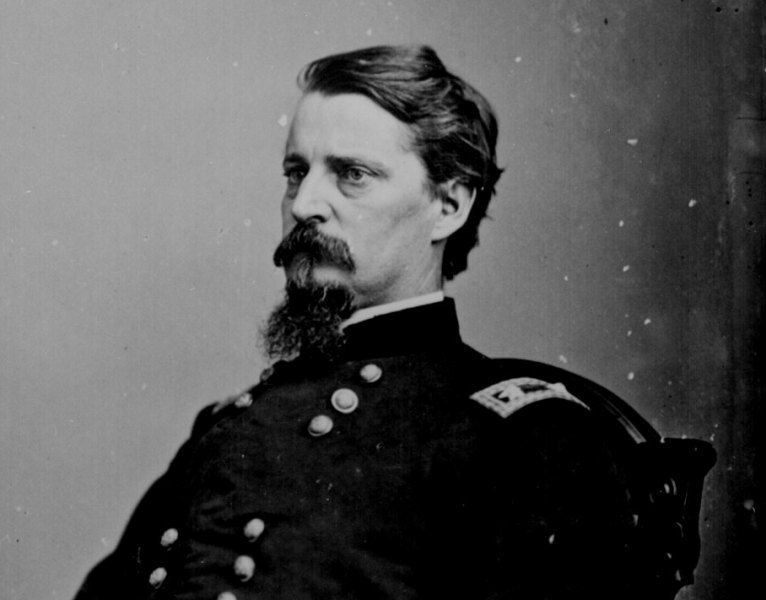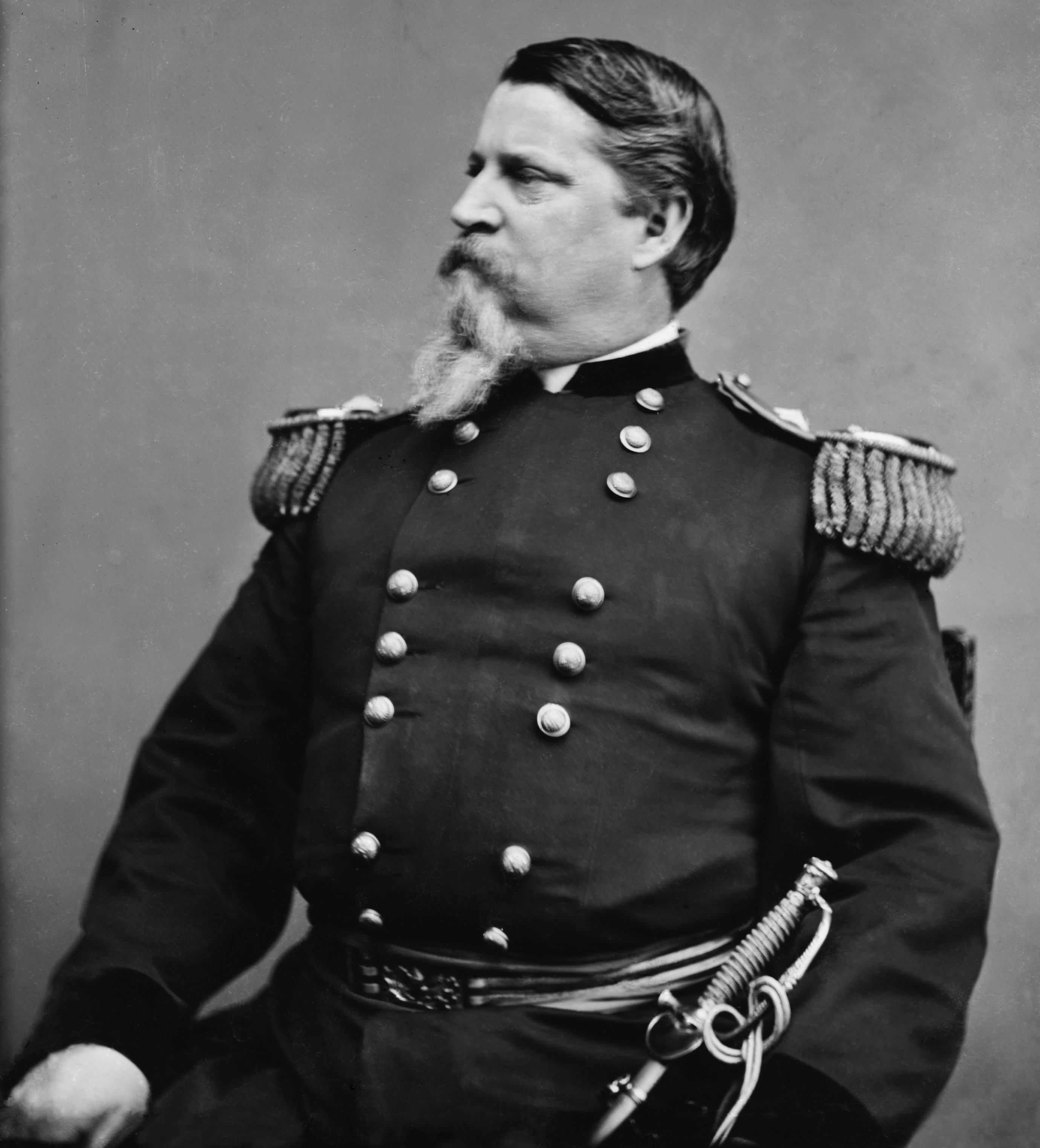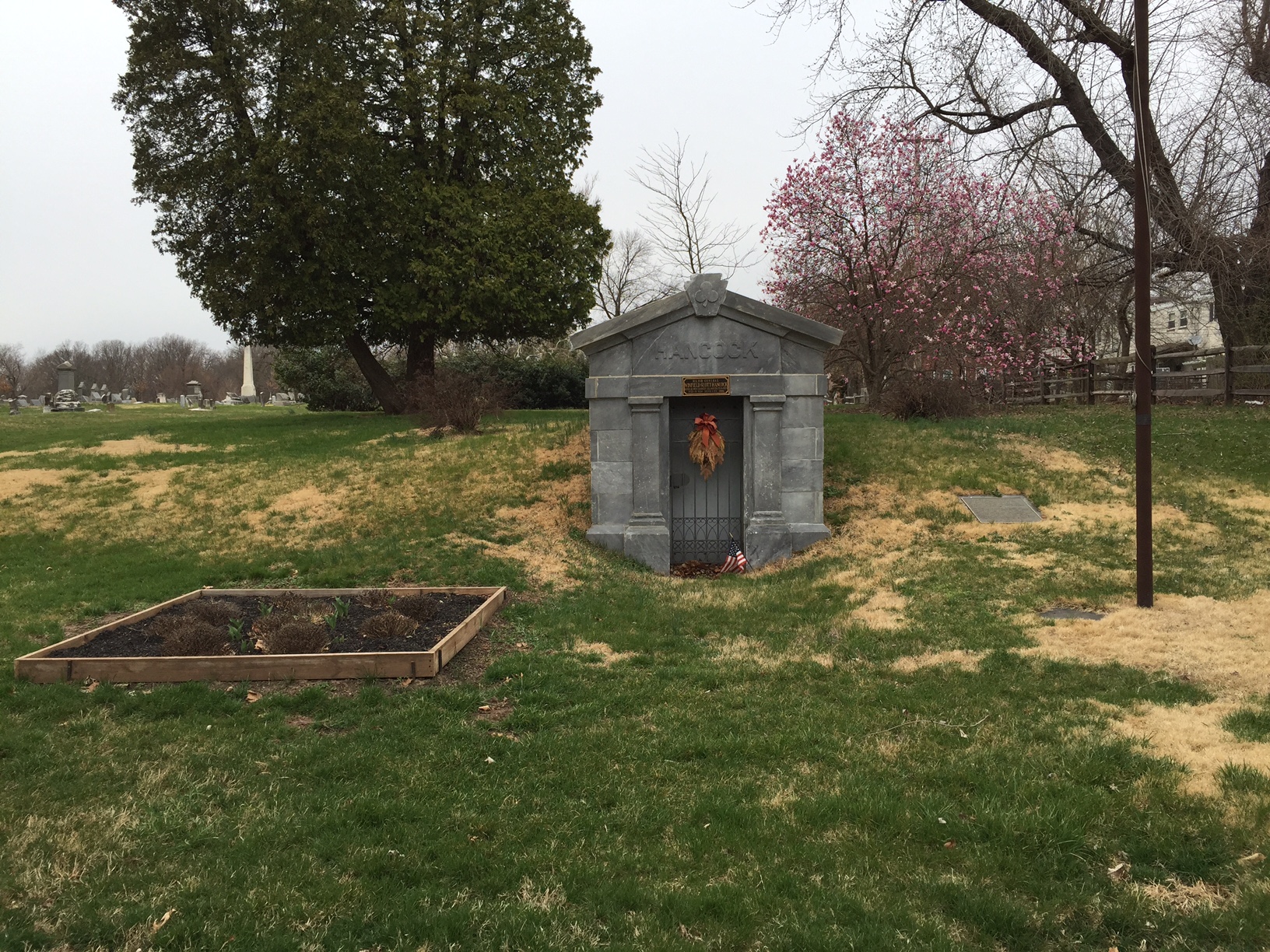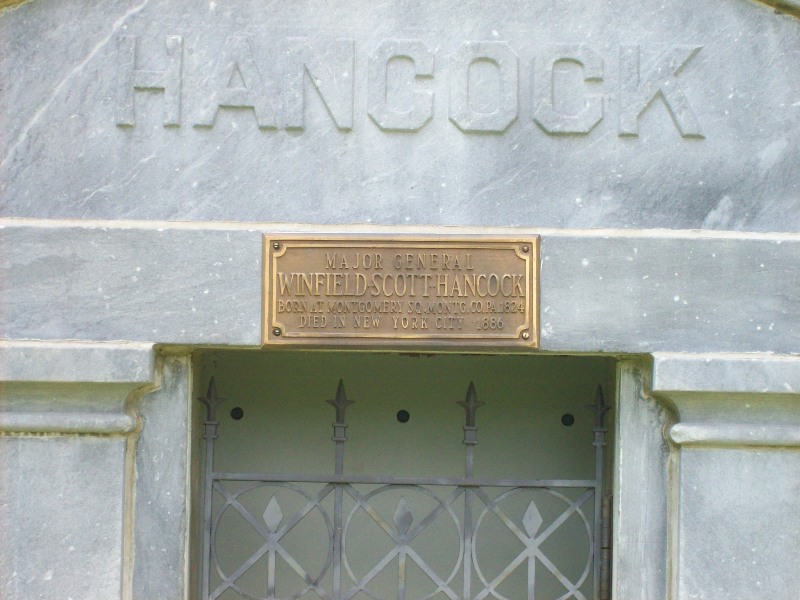Born with an identical twin brother near present-day Montgomeryville, Montgomery County, Pennsylvania, in 1840, he received an appointment to the United States Military Academy at West Point, New York, by Congressman Joseph Fornance. He graduated in 18th out of 25 in the class of 1844 that included future Confederate Generals Simon Bolivar Buckner and Daniel M. Frost, and future Union Generals Alexander Hays and Alfred Pleasonton.
Posted to the 6th United States Infantry, he served on the western frontier until the Mexican War. During that conflict, he saw his first combat at the Battles of Contreras and Churubusco, where he was wounded. After the Battle of Molino Del Rey, he became prostrate with sickness, and missed being part of Major General Winfield Scott's march from Vera Cruz to Mexico City, the campaign that ended the war. In the late 1840s and the 1850s, he served first as a Regimental Adjutant, then as Quartermaster stationed at various posts in the United States and frontier. In St. Louis, Missouri, in 1850, he met and married Almira Russell.
Promoted to Captain in the late 1850s, he was stationed as Quartermaster of the small outpost of Los Angeles, California, where he became friends with fellow Army officer and future Confederate General Lewis A. Armistead. When the Civil War began, Armistead and other Southern-born officers resigned and left to join the Confederacy, with Captain Hancock leaving to help raise the growing Union Army.
Commissioned Brigadier General of the United States Volunteers on September 23, 1861, he was assigned to command a brigade in the Army of the Potomac's II Corps. In the opening stages of the 1862 Peninsular Campaign under Major General George B. McClellan, he led his brigade during the May 5, 1862, Battle of Williamstown, where, despite orders from Corps commander Major General Edwin V. Sumner Sr. to withdraw, he held his ground against an attack by the Confederates, then enacted a counterattack that cleared the area of the rebels. In his dispatches describing the engagement to Washington, D.C., General McClellan described General Hancock's performance as "superb," which caused the press to give him the appellation "Hancock the Superb." He continued to command his brigade through the June-July 1862 Seven Days Battles and the August 1862 Second Bull Run Campaign.
On September 17, 1862, during the Battle of Antietam, Maryland, he ascended to command a division when Major General Israel B. Richardson was mortally wounded in the Army of the Potomac's assaults on the "Bloody Lane." During the December 13, 1862, Battle of Fredericksburg, three of his II Corp brigades constituted the second assault on strong Confederate positions along Marye's Heights. Although reaching farther than any other Union troops, they failed to reach the Confederate line and were repulsed with great casualties.
In the winter of 1862-1863, he did not participate in the revolt of the high command of the Army of the Potomac against Major General Ambrose E. Burnside, who was eventually replaced by Major General Joseph Hooker. When spring arrived, General Hooker enacted a brilliant flank march on the Army of Northern Virginia at Chancellorsville, but subsequently gave up the initiative to Confederate General Robert E. Lee, resulting in the defeat of the Union Army in that battle. General Hancock's division covered the Army of the Potomac's retreat over the Rappahannock River, and he was wounded during the withdrawal. II Corps commander Major General Darius N. Couch resigned in disgust after the battle, and General Hancock was elevated to command the II Corps.
On the opening day of the Battle of Gettysburg, he was sent by new Army of the Potomac commander Major General George G. Meade to take charge of the Union troops after they had been sent in retreat after hard fighting north and west of the town. This assignment by Meade was made despite Hancock being lower in rank than XI Corps commander Major General Oliver O. Howard (with whom he allegedly argued with upon arriving on the scene). General Hancock organized the retreating troops on Cemetery Hill and was responsible for selecting and posting the strong positions where the Army would subsequently fight through the rest of the battle.
On July 2, the second day of the battle, he directed his Corps' defense of Cemetery Ridge from Confederate assaults by troops under Lieutenant General James Longstreet, at one point famously directing the 1st Minnesota Volunteer Infantry to make a suicidal charge into oncoming rebels to buy time for him to plug a critically-weak hole in the Union lines.
His Corps bore much of the brunt of repulsing Pickett's Charge on July 3, 1863. Hancock was wounded in the saddle and refused to leave the field until the Confederates were in retreat. The battle ended with the rebels defeated, due to a large part in General Hancock's efforts and leadership, for which he was eventually voted the thanks of Congress.
He convalesced in his hometown of Norristown, Pennsylvania, and would not return to his command until 1864. Hobbled and weakened by his wounds, his performance in the subsequent battles of the 1864 Overland Campaign and the Siege of Petersburg, Virginia were uneven, as he frequently directed the fighting from an ambulance wagon.
At the May 12, 1864, Battle of Spotsylvania, he directed his Corps as it smashed the Confederate "Mule Shoe" protrusion, although it had to eventually retreat as its success was unsupported. During the August 1864 Battle of Ream's Station, despite his personal bravery on the field, his men were unable to resist Confederate counterattacks and were defeated. Finally, in November 1864, his health failing, he left field service to command the Veterans Reserve Corps, and later, the Middle Military Department, headquartered at Washington, D.C., holding that position through the end of the war.
After the assassination of President Abraham Lincoln and the trial and sentencing of the assassination conspirators, the duty fell to him to carry out their executions, doing so on July 7, 1865. He ended the war as a Brigadier General and Brevet Major General in the Regular Army.
Post-war, he was assigned first to command the Department of Missouri, where he was involved in negotiations with various native American tribes on the western frontier; then the military district overseeing occupation and reconstruction in Texas and Louisiana, finally the Department of the Dakotas, where he again was involved in peacekeeping and negotiations with Indian tribes.
Having been promoted to Major General in the Regular Army in 1866, he became senior Army officer at that rank when General Meade died in November 1872, succeeding General Meade as commander of the Department of the Atlantic.
A lifelong Democrat, he accepted the Democratic Party's nomination for President of the United States in 1880. Running against fellow Civil War Union Army General James A. Garfield, General Hancock lost the popular vote by a slim margin, but the Electoral College loss was much wider.
He finished out his remaining years in active duty. He was named the head of a number of veteran organizations such as the Military Order of the Loyal Legion of the United States. As Military Department chief of the area that included New York City, he presided over the massive public funeral afforded to President Ulysses S. Grant in 1885. Less than a year later, he died from complications of diabetes at his post on Governor's Island in New York City Harbor.
Today an equestrian statue stands for him on East Cemetery Hill in the Gettysburg National Military Park, and another one stands for him on Pennsylvania Avenue in Washington, D.C. In 1995, the United States Post Office issued a commemorative stamp in his honor.
Born with an identical twin brother near present-day Montgomeryville, Montgomery County, Pennsylvania, in 1840, he received an appointment to the United States Military Academy at West Point, New York, by Congressman Joseph Fornance. He graduated in 18th out of 25 in the class of 1844 that included future Confederate Generals Simon Bolivar Buckner and Daniel M. Frost, and future Union Generals Alexander Hays and Alfred Pleasonton.
Posted to the 6th United States Infantry, he served on the western frontier until the Mexican War. During that conflict, he saw his first combat at the Battles of Contreras and Churubusco, where he was wounded. After the Battle of Molino Del Rey, he became prostrate with sickness, and missed being part of Major General Winfield Scott's march from Vera Cruz to Mexico City, the campaign that ended the war. In the late 1840s and the 1850s, he served first as a Regimental Adjutant, then as Quartermaster stationed at various posts in the United States and frontier. In St. Louis, Missouri, in 1850, he met and married Almira Russell.
Promoted to Captain in the late 1850s, he was stationed as Quartermaster of the small outpost of Los Angeles, California, where he became friends with fellow Army officer and future Confederate General Lewis A. Armistead. When the Civil War began, Armistead and other Southern-born officers resigned and left to join the Confederacy, with Captain Hancock leaving to help raise the growing Union Army.
Commissioned Brigadier General of the United States Volunteers on September 23, 1861, he was assigned to command a brigade in the Army of the Potomac's II Corps. In the opening stages of the 1862 Peninsular Campaign under Major General George B. McClellan, he led his brigade during the May 5, 1862, Battle of Williamstown, where, despite orders from Corps commander Major General Edwin V. Sumner Sr. to withdraw, he held his ground against an attack by the Confederates, then enacted a counterattack that cleared the area of the rebels. In his dispatches describing the engagement to Washington, D.C., General McClellan described General Hancock's performance as "superb," which caused the press to give him the appellation "Hancock the Superb." He continued to command his brigade through the June-July 1862 Seven Days Battles and the August 1862 Second Bull Run Campaign.
On September 17, 1862, during the Battle of Antietam, Maryland, he ascended to command a division when Major General Israel B. Richardson was mortally wounded in the Army of the Potomac's assaults on the "Bloody Lane." During the December 13, 1862, Battle of Fredericksburg, three of his II Corp brigades constituted the second assault on strong Confederate positions along Marye's Heights. Although reaching farther than any other Union troops, they failed to reach the Confederate line and were repulsed with great casualties.
In the winter of 1862-1863, he did not participate in the revolt of the high command of the Army of the Potomac against Major General Ambrose E. Burnside, who was eventually replaced by Major General Joseph Hooker. When spring arrived, General Hooker enacted a brilliant flank march on the Army of Northern Virginia at Chancellorsville, but subsequently gave up the initiative to Confederate General Robert E. Lee, resulting in the defeat of the Union Army in that battle. General Hancock's division covered the Army of the Potomac's retreat over the Rappahannock River, and he was wounded during the withdrawal. II Corps commander Major General Darius N. Couch resigned in disgust after the battle, and General Hancock was elevated to command the II Corps.
On the opening day of the Battle of Gettysburg, he was sent by new Army of the Potomac commander Major General George G. Meade to take charge of the Union troops after they had been sent in retreat after hard fighting north and west of the town. This assignment by Meade was made despite Hancock being lower in rank than XI Corps commander Major General Oliver O. Howard (with whom he allegedly argued with upon arriving on the scene). General Hancock organized the retreating troops on Cemetery Hill and was responsible for selecting and posting the strong positions where the Army would subsequently fight through the rest of the battle.
On July 2, the second day of the battle, he directed his Corps' defense of Cemetery Ridge from Confederate assaults by troops under Lieutenant General James Longstreet, at one point famously directing the 1st Minnesota Volunteer Infantry to make a suicidal charge into oncoming rebels to buy time for him to plug a critically-weak hole in the Union lines.
His Corps bore much of the brunt of repulsing Pickett's Charge on July 3, 1863. Hancock was wounded in the saddle and refused to leave the field until the Confederates were in retreat. The battle ended with the rebels defeated, due to a large part in General Hancock's efforts and leadership, for which he was eventually voted the thanks of Congress.
He convalesced in his hometown of Norristown, Pennsylvania, and would not return to his command until 1864. Hobbled and weakened by his wounds, his performance in the subsequent battles of the 1864 Overland Campaign and the Siege of Petersburg, Virginia were uneven, as he frequently directed the fighting from an ambulance wagon.
At the May 12, 1864, Battle of Spotsylvania, he directed his Corps as it smashed the Confederate "Mule Shoe" protrusion, although it had to eventually retreat as its success was unsupported. During the August 1864 Battle of Ream's Station, despite his personal bravery on the field, his men were unable to resist Confederate counterattacks and were defeated. Finally, in November 1864, his health failing, he left field service to command the Veterans Reserve Corps, and later, the Middle Military Department, headquartered at Washington, D.C., holding that position through the end of the war.
After the assassination of President Abraham Lincoln and the trial and sentencing of the assassination conspirators, the duty fell to him to carry out their executions, doing so on July 7, 1865. He ended the war as a Brigadier General and Brevet Major General in the Regular Army.
Post-war, he was assigned first to command the Department of Missouri, where he was involved in negotiations with various native American tribes on the western frontier; then the military district overseeing occupation and reconstruction in Texas and Louisiana, finally the Department of the Dakotas, where he again was involved in peacekeeping and negotiations with Indian tribes.
Having been promoted to Major General in the Regular Army in 1866, he became senior Army officer at that rank when General Meade died in November 1872, succeeding General Meade as commander of the Department of the Atlantic.
A lifelong Democrat, he accepted the Democratic Party's nomination for President of the United States in 1880. Running against fellow Civil War Union Army General James A. Garfield, General Hancock lost the popular vote by a slim margin, but the Electoral College loss was much wider.
He finished out his remaining years in active duty. He was named the head of a number of veteran organizations such as the Military Order of the Loyal Legion of the United States. As Military Department chief of the area that included New York City, he presided over the massive public funeral afforded to President Ulysses S. Grant in 1885. Less than a year later, he died from complications of diabetes at his post on Governor's Island in New York City Harbor.
Today an equestrian statue stands for him on East Cemetery Hill in the Gettysburg National Military Park, and another one stands for him on Pennsylvania Avenue in Washington, D.C. In 1995, the United States Post Office issued a commemorative stamp in his honor.
Bio by: RPD2
Family Members
Advertisement
See more Hancock memorials in:
Records on Ancestry
Advertisement

















